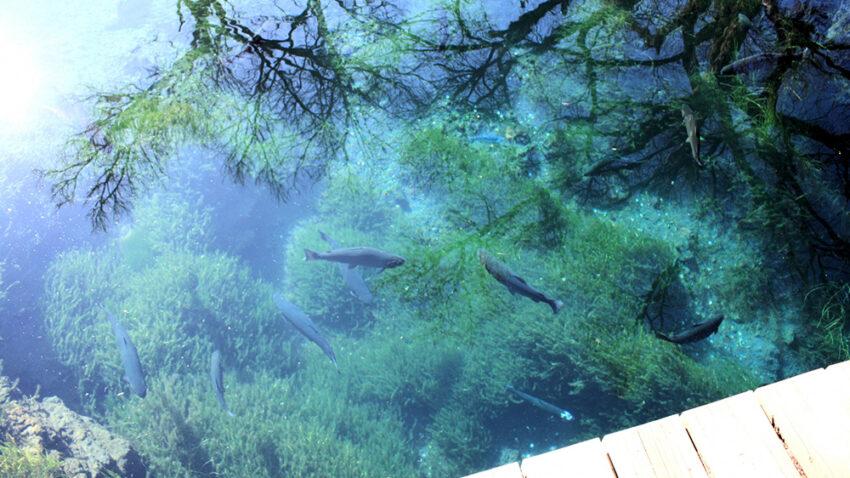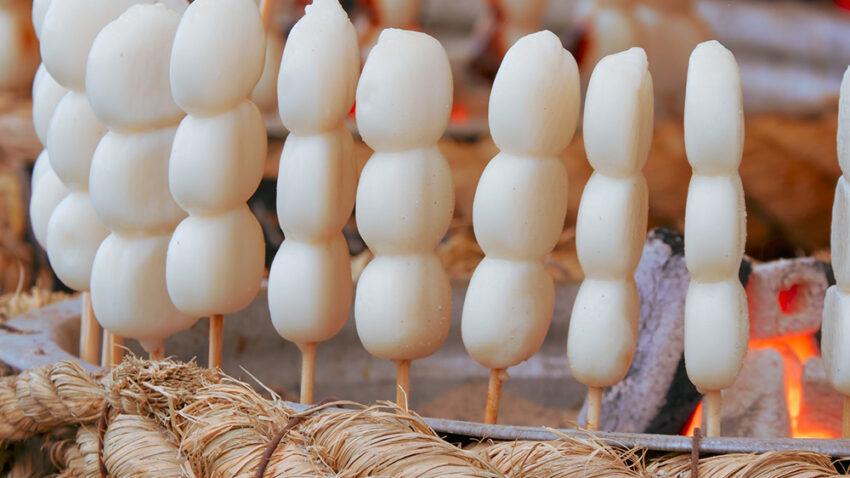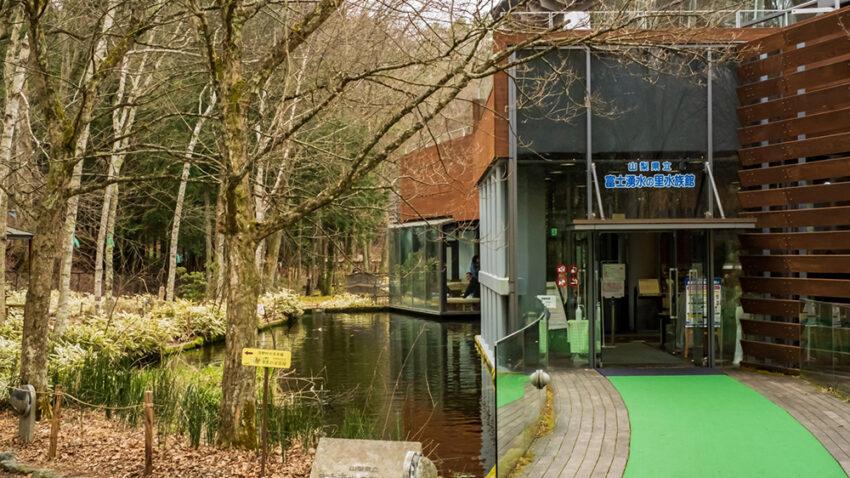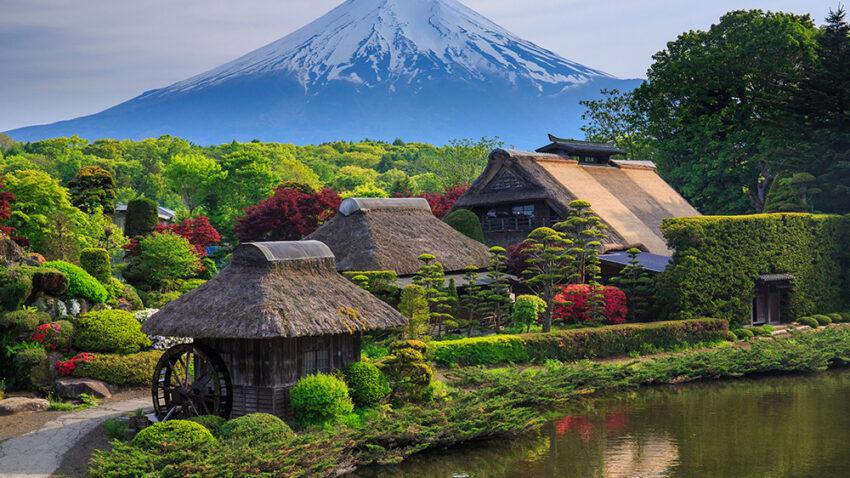Oshino Hakkai is a unique spot in the Fuji Five Lakes region. Here you will find the legendary eight ponds that are filled with the fresh snowmelt from Mount Fuji. Nature lovers in Japan that are looking to see a different side of Japan will definitely be surprised (in a good way!) by the beauty of Oshino Hakkai. If you are in search of a refreshing day trip from Tokyo, read on for more information about Oshino Hakkai!
Tokyo Travel Assist offers a car-based private tour of Oshino Hakkai and Mt. Fuji.
About Oshino Hakkai(忍野八海)
Oshino Hakkai, literally “eight seas” in Japanese, is a set of eight ponds in the small village of Oshino in the Fuji Five Lakes region. Situated between Lake Kawaguchiko and Lake Yamanakako, Oshino Hakkai was the site of a sixth lake that dried out many centuries ago. The water in the eight ponds comes from the melted snow on Mount Fuji, which filters through porous volcanic rock. This process takes several decades and is the reason why the water in the ponds is so clear and pristine.

The eight ponds
The names of the eight ponds are Deguchi-ike, Okama-ike, Sokonashi-ike, Choshi-ike, Waku-ike, Nigori-ike, Kagamiike, and Shobu-ike. The name of each pond represents a certain feature of the pond. For example, Deguchi-ike is the largest of the eight ponds and is located near the exit (deguchi) of the village. Also, Kagami-ike is said to offer the clearest image of Mount Fuji on the surface of the pond just like a mirror (kagami).

You will find the ninth pond called Naka-ike right by the souvenir shops at Oshino Hakkai. Unlike the other ponds, Naka-ike is an artificial pond. The water is so clear and blue that you can see the very bottom of the pond! Additionally, there is a small fountain that looks like a waterfall on the walkway to Naka-ike. The legendary spring water of Oshino Hakkai comes out of this fountain. Try sipping some of this super clean water, or purchase an empty plastic bottle and take some for the road.
Exploring Oshino Hakkai

Oshino Hakkai area is a very popular tourist spot for both local Japanese people as well as international tourists. The site offers visitors the chance to visit several restaurants, souvenir shops, and food stands while touring the ponds. The eight ponds are all within walking distance from each other. So, you can enjoy the sights and smells of the small village-like park while learning about the eight ponds. Located on site is an open-air museum called Hannoki Bayashi Shiryokan(榛の木林資料館) where you can admire displays of old farming tools and samurai weapons. Entry to Sokonashi-ike, which offers the best views of Mount Fuji, is also found in this museum. The museum charges a small entrance fee and is open from 9 AM to 5 PM.
After touring the ponds and museum, why not stop at one of the food stands? The small food stands that line the streets sell local snacks like grilled sweetfish or mochi skewers called dango. Not only are these foods incredibly delicious, but they are photogenic too.
By the way, you might notice that the building roofs around Oshino Hakkai look a bit different than regular roofs. The buildings at Oshino Hakkai are made with traditional thatched roofs, which were a common type of roof in rural Japan. People in Japan built buildings with thatched roofs from the Jomon era (c. 14,000–300 BCE) until the mid-20th century. You may have seen these types of houses at Shirakawa-go in Gifu prefecture, which might be the most popular place to view these traditional Japanese buildings. However, Oshino Hakkai also offers the chance to see these rare buildings without the long train journey. Tokyo Travel Assist coordinates a private tour for Oshino Hakkai.
Oshino Hakkai area map
How to get to Oshino Hakkai
To access the Oshino Hakkai area from Tokyo, we recommend first heading to Kawaguchiko Station. Highway buses depart from Shinjuku Station, Shinagawa Station, and Tokyo Station, and will take you straight to Kawaguchiko Station – no transfer necessary! Alternatively, you can rent a car and drive to Oshino Hakkai.
Via local bus
From Kawaguchiko Station, you can take the bus that runs between Kawaguchiko and Gotemba Station. Most of the buses that run this route stop at Oshino Hakkai, usually one every hour. If you are unsure if the bus will stop at Oshino Hakkai, check the bus timetable at the bus stop.

Fujikko tourist bus(ふじっ湖号)
The Fujikko tourist buses or the Mount Fuji World Heritage Loop buses are the perfect choices for those who want to see all that the Mount Fuji area has to offer. These loop buses provide an easy transportation method around the main sightseeing spots in the Fuji Five Lakes area, including Oshino Hakkai. The Fujikko tourist buses leave Kawaguchiko station every hour and go in a circle around Lake Kawaguchiko, Fujiyoshida, Oshino Hakkai and Lake Yamanakako. There is a 2-day unlimited pass for the Fujikko tourist bus available for 1500 yen, which we recommend for those who plan to stay overnight in the Fuji Five Lakes area. You will get off the bus at the “Oshino Hakkai” bus stop.
Mount Fuji World Heritage Loop bus(富士山世界遺産ループバス)
On the other hand, the Mount Fuji World Heritage Loop bus departs every 90 minutes from Kawaguchiko station. This bus goes from Kawaguchiko and around Chureito Pagoda and Oshino Hakkai. There is also a 2-day unlimited bus pass for the Mount Fuji World Heritage Loop bus available for 1050 yen, which we recommend for those staying overnight and planning to visit Chureito Pagoda in addition to Oshino Hakkai. Like the Fujikko bus, please get off the bus at the “Oshino Hakkai” bus stop.
By car
For those who plan to visit Oshino Hakkai by car please note that there is paid parking around the park. During the weekends and holidays the best spots fill up fast, so please keep that in mind! Also, you must have a valid international driver’s license to drive a car in Japan. Please inquire with your local embassy for more information about the license requirements.
Other sights to see
Shinobi no Sato(しのびの里)

Have you ever wanted to test your Ninja skills? Or maybe you plan on visiting Oshino Hakkai with your family and want a memorable experience for the kids. Either way, Shinobi no Sato is for you!
Shinobi no Sato is a ninja-themed village located near Oshino Hakkai. Visitors can transform into ninjas while enjoying the view of Mount Fuji in the background. There are many activities and displays that would surely entertain anyone curious about Japanese ninjas. For the kids, the Shuriken throwing challenge is a perfect way to try being a ninja. Hit the targets and you might even win a prize! To learn more about ninjas, watch one of the ninja performances. Intense acrobatics and ninja skills are super exciting to watch.
Also, be sure to make a stop at the Karakuri house. This house is filled with booby traps, secret rooms, and more. Ninjas used to live in houses like Karakuri house use to protect themselves from unwelcome visitors. See if you can spot the tricky traps or get caught in them!
Besides the ninja activities, there is a tea house that serves authentic Japanese matcha with a Shinobi no Sato original snack. After a long day of walking, soak your tired feet in the public foot bath (ashiyu). The foot baths are especially relaxing in the winter months! If you are hungry, sit down and enjoy an authentic Japanese meal at the restaurant. Tokyo Travel Assist coordinates a private tour for Shinobi no Sato.
Address: 2845 Shibokusa, Oshino, Minamitsuru District, Yamanashi(Map)
Tel: 0555-84-1122
Hours: Hours vary each season, please check the website here
Kaneyama Waterfall(鐘山の滝)
Kaneyama waterfall is a beautiful waterfall near Oshino Hakkai. From Oshino Hakkai, you can reach the falls in about 15 by bus or 8 minutes by car.

The fall flows from the Katsura River in Yamanashi and gets water from Lake Yamanakako and Oshino Hakkai. Kaneyama waterfall has a drop of 10 meters with two streams. You can enjoy the scenery year-round as the area is cool in the summer, has beautiful azalea flowers in spring, and bright green plants all around in summer. However, the most popular season to make the trip to Kaneyama Waterfall is autumn. The bright red and orange leaves in autumn frame Kaneyama waterfall. Whether you take a photo on your smartphone or DSLR camera, you are bound to capture an amazing shot!
Address: Kamiyoshidahigashi, Fujiyoshida, Yamanashi(Map)
Benifuji no Yu(紅富士の湯)
Benifuji no Yu is an onsen (hot spring) located just a few blocks away from the shore of Lake Yamanaka, the largest of the Fuji Five Lakes. The outdoor baths offer incredible views of “Benifuji”. “Benifuji”, or red Fuji, happens when the snow on Mount Fuji appears to have a rosy pink hue, especially in winter mornings.

Benifuji no Yu is a real Japanese onsen experience. Strip down to your birthday suit and wash up before entering the baths. The numerous baths provide a different experience. Enjoy each unique bath while basking in the beauty of Mount Fuji. The scenery is slightly different during each season, with snow all around in the winter and bright greenery in the summer. After your fill of the baths, you can relax in the lounge area. To make your visit extra memorable, you should stop by the cafeteria for some fresh local dishes.
Address: 2845 Shibokusa, Oshino, Minamitsuru District, Yamanashi(Map)
Tel: 0555-84-1122
Hours: 11 AM ~ 8 PM
Sakana Park(さかな公園)
Sakana Park is a water and forest-themed park in Oshino Village. You can learn about plants and animals that live together around Mount Fuji. Located in the park are two main facilities: Fuji Yusui no Sato Aquarium (Fuji Spring Water Village Aquarium) and Mori no Gakushukan (Oshino Village Forest Learning Center).
Fuji Yusui no Sato Aquarium(富士湧水の里水族館)

You can see many kinds of freshwater fish swimming around in the indoor and outdoor pools at Fuji no Yusui no Sato Aquarium. Did you know that there are around 3000 kinds of freshwater fish in the waters that come from Mount Fuji? A number of them live at the Fuji Yusui no Sato Aquarium. Fish feeding sessions and special exhibitions are also held here on an irregular basis.
Mori no Gakushukan(森の学習館)
At Mori no Gakushukan, learn about different plants and animals that live in the forests around Oshino Village and Japan. One of the highlights of Mori no Gakushukan is the displays of local plants and animals. Also, there is an area to learn about medicinal plants. For the kids and any of the young at heart, try fishing for conifer cone “fish” in a sea of wood shavings. Alternatively, try your hand at some crafts with natural materials sourced around Oshino Village.
At Sakana Park, there is also a playground area for children that is made of wood. In the summer, visitors can play in the “Jabujabu pond” to cool down from the sweltering summer heat.
Address: 3098-1 Shibokusa, Minamitsurugun Oshinomura, Yamanashi(Map)
Tel: 0555-84-7261
Hours: 9 AM ~ 5 PM
Local Cuisine
Restaurants and food stands fill the streets around Oshino Hakkai. You can try local Yamanashi cuisine at one of the shops. Keep reading to see our recommendations for delicious local cuisine.
Tenshoan(天祥庵)
Tenshoan is a soba restaurant found near Shinobi no Sato. Soba noodles are made with buckwheat, unlike ramen or udon which are usually made with flour. The restaurant itself will take you back to old Japan with the thatched roof and traditional interior, complete with tatami mats. The buckwheat noodles made fresh each day are so popular with the many tourists that visit.

Address: 2848-2 Shinobiku, Oshino-mura, Minamitsuru-gun, Yamanashi(Map)
Tel: 0555-84-4119
Hours: 11 AM ~ 2:30 PM
Maruten(丸天)

Maruten is a restaurant that specializes in local Yamanashi cuisine. The most famous dish at Maruten is certainly houtou, a noodle soup that originates from Yamanashi prefecture. There are a few urban legends as to how houtou originated in Yamanashi. One such legend credits the lack of rice harvest in the region for the creation of houtou. On the other hand, some people say that warlord Takeda Shingen created houtou by cutting noodles with his treasured sword, called a houtou in Japan.
Houtou is made by boiling noodles with Japanese pumpkin, green onion, pork, or other vegetables in a miso-based broth. The noodles in houtou are noticeably short and flat in contrast to the other famous types of noodles in Japan like soumen or ramen which are usually thin and long. Houtou is a must-try dish for anyone visiting Oshino Hakkai and the surrounding area.
Address: 114 Shibokusa, Oshino, Minamitsuru District, Yamanashi(Map)
Tel: 0555-84-2109
Hours: 11 AM ~ 4 PM *Closed every Wednesday
History of Oshino Hakkai
In the olden days, Oshino Hakkai was called Fujisan Nemoto Hakko Sacred Grounds, or the Moto-Hakko. Eight is an important number in Buddhism due to the Eightfold Path. With Buddhism being a significant religion in Japan, Japanese people in previous eras included the circuit of the eight ponds as an important part of the pilgrimage to Mount Fuji. Religious groups would purify themselves in the springs of Oshino Hakkai before making the trek up Mount Fuji. Due to its historical and cultural significance, Oshino Hakkai was designated a Natural Monument of Japan in 1934 and has been part of the Mount Fuji World Heritage Sight since 2013.
You probably want to visit Oshino Hakkai now that you learned about the amazing eight ponds and other nearby sights. If you require a friendly Japanese guide to help you get around Oshino Hakkai, look no further! The guides here at Tokyo Travel Assist are here to help. Get in touch with us today and let us know what you plan to do on a trip to Oshino Hakkai!

